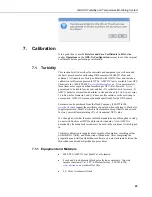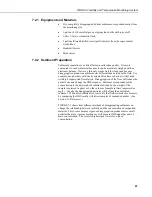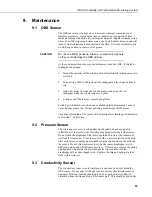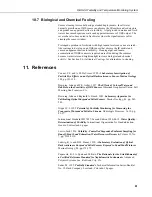
OBS-3A Turbidity and Temperature Monitoring System
Sediment concentrations are calculated with the following equations:
mg/l
ρ
M
V
M
s
s
i
s
=
⎥
⎦
⎤
⎢
⎣
⎡
+
;
ppm
M
M
i
s
=
+
M
s
Where:
M
s
= Mass (mg) of sediment in suspension
M
i
= Initial water mass,
)
(
1
i
kg
V
×
V
i
= Initial volume (L)
ρ
s
= Sediment density (usually
)
l
/
mg
10
65
.
2
3
×
7.
For the zero calibration point you will need a clean black 20 x 14 x 16 inch
container filled with clean tap water. A Rubbermaid® plastic storage box
is suitable.
8.
Add 2 L of filtered water to the 1 gallon container submerging the sensor
at least 5 cm; tap bubbles off container walls.
9.
Weigh 5 to l0 equal increments of the sediment so that the total dry weight
will produce the maximum concentration expected at the monitoring site.
10.
For each sediment standard, repeat Steps 2 and 3 of Section 7.1.3,
HydroSci Software Steps
.
11.
After all sediment values have been logged, follow Steps 4 through 7 of
Section 7.1.3,
HydroSci Software Steps
, to complete the calibration.
7.3 Salinity, Pressure and Temperature Calibrations
Due to the specialized equipment involved for salinity, pressure and
temperature calibration, it is recommended that the instrument be returned to
Campbell Scientific, Inc. if any of these sensors are not operating with
specified accuracy. Products may not be returned without prior authorization.
Refer to the Assistance section at the beginning of this manual for the proper
procedure for returning products to Campbell Scientific.
8. Troubleshooting
This section will help you isolate problems that can be easily fixed such as
cable-continuity, processor reset, and battery replacement from serious ones
such as sensor, computer and electronic malfunctions, and damaged
mechanical parts that will require our help. The problem symptoms are shown
with underlined, bold text.
49






























